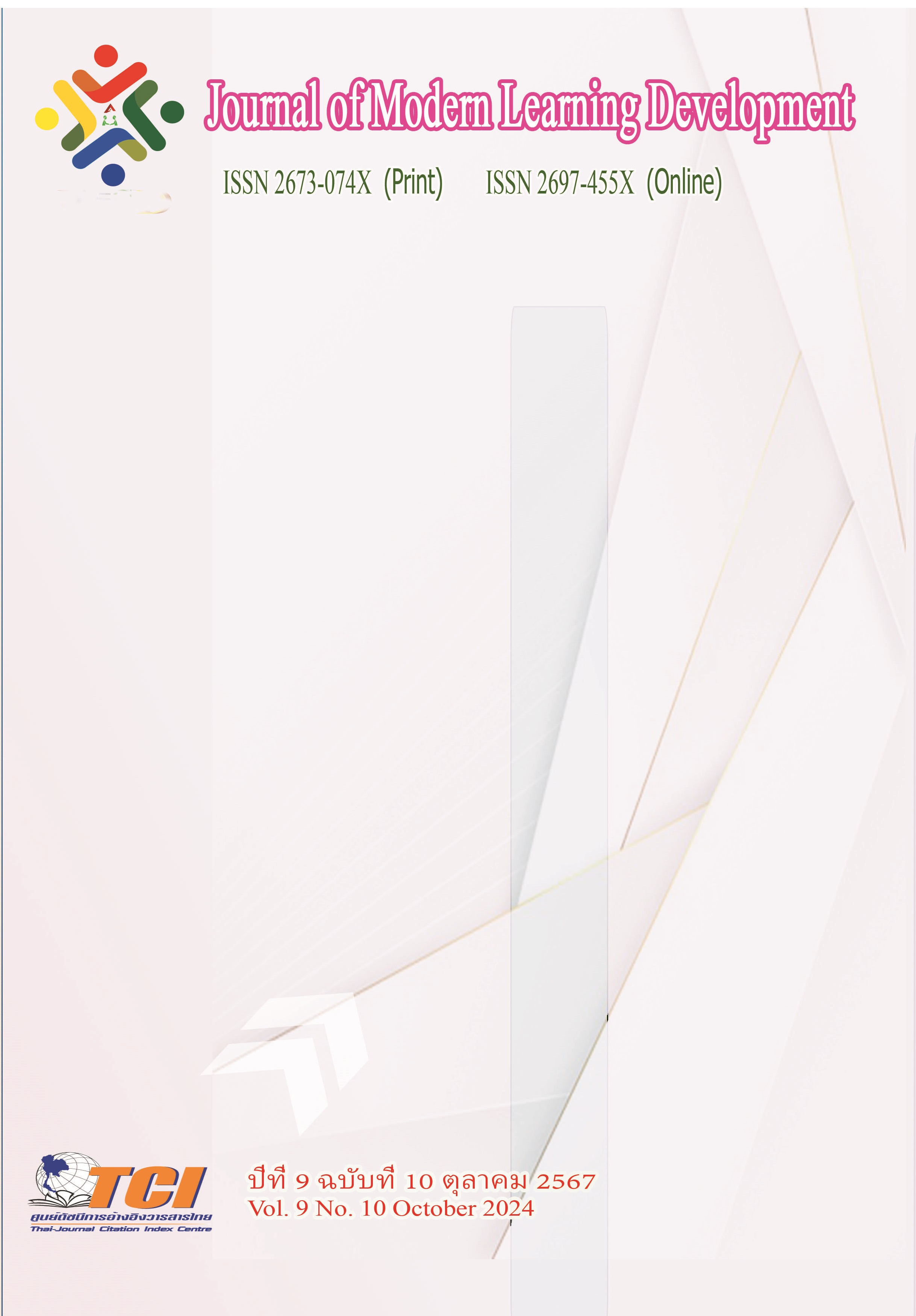แก้วน้ำปริศนาของ จ่าง แซ่ตั้ง ผันพลังสรรสร้างสู่สุ้มเสียง
Main Article Content
บทคัดย่อ
การวิจัยนี้ เป็นการวิจัยเชิงสร้างสรรค์ “แก้วน้ำปริศนาของ จ่าง แซ่ตั้ง ผันพลังสรรสร้างสู่สุ้มเสียง” ได้แรงบันดาลใจจากบทกวีรูปธรรมรูปทรงแก้วน้ำ ของจ่าง แซ่ตั้ง มีวัตถุประสงค์เพื่อ 1) สร้างสรรค์บทเพลงบรรเลง “แก้วน้ำปริศนา” ในลักษณะดนตรีร่วมสมัย 2) นำไปบรรเลงด้วยวงสตริงคอมโบ ศึกษาแนวคิดและทฤษฎีจากเอกสารและงานวิจัย เก็บข้อมูลโดยการสัมภาษณ์ผู้ให้ข้อมูลสำคัญ ได้แก่ นักวิชาการด้านดนตรี ผู้เชี่ยวชาญด้านวรรณกรรม และผู้เชี่ยวชาญด้านการสื่อความหมายทางดนตรี คัดเลือกโดยพิจารณาจากผลงานวิจัยและผลงานสร้างสรรค์ที่เกี่ยวข้อง ด้วยแบบสัมภาษณ์ด้านการสื่อความภาษา การประพันธ์เพลงไทย การประพันธ์เพลงสากล วิเคราะห์ข้อมูลกำหนดประเด็นการสร้างสรรค์ เรียบเรียงเสียงประสานตามหลัก
ดุริยางคศาสตร์สากลและอธิบายรายละเอียดการสร้างสรรค์
ผลการวิจัย (1) งานสร้างสรรค์มีโครงสร้างหลัก 5 ตอน ABCDA ใช้อัตราจังหวะ , , และ อัตราความเร็ว 80 Bpm และ160 Bpm ทำนองผสมผสานสำเนียงแบบสากลและไทยเดิม ใช้คอร์ดทบ 7 ตอน A อยู่บนบันไดเสียง C เมเจอร์ สื่อความถึงชีวิต ตอน B อยู่บนบันไดเสียง C เมเจอร์ สื่อความถึงคน ตอน C อยู่บนบันไดเสียง E ไมเนอร์ สื่อความถึงเวลา ตอน D อยู่บนบันไดเสียง C เมเจอร์ บรรเลงโดยใช้คีตปฏิภาณเพื่อถ่ายทอดอารมณ์ของผู้บรรเลง ย้อนความจบด้วยด้วยตอน A (2) งานสร้างสรรค์ “แก้วน้ำปริศนาของ จ่าง แซ่ตั้ง ผันพลังสรรสร้างสู่สุ้มเสียง” ผู้สร้างสรรค์ได้กำหนดรูปแบบของวงที่บรรเลงคือ วงสตริงคอมโบ ซึ่งประกอบด้วย กลองชุด กีตาร์เบสไฟฟ้า กีตาร์ไฟฟ้า เปียโน ทรัมเป็ต ทรอมโบน และเทนเนอร์แซกโซโฟน ดำเนินทำนองโดยกีตาร์ไฟฟ้า นอกจากนี้สามารถปรับเครื่องดนตรีและเนื้อหาดนตรีตามความเหมาะสมได้
Article Details
เอกสารอ้างอิง
กฤติน นกแก้ว. (2563). การวิเคราะห์ผลงานการประพันธ์เพลงสมัยนิยมของ ประภพ ชมถาวร. วิทยานิพนธ์ ศิลปศาสตรมหาบัณฑิต. สาขาวิชามนุษยดุริยางควิทยา. คณะศิลปกรรมศาสตร์. บัณฑิตวิทยาลัย: มหาวิทยาลัยศรีนครินทรวิโรฒ.
จ่าง แซ่ตั้ง. (2553). บทกวีของฉัน: จ่าง แซ่ตั้ง. กรุงเทพมหานคร: โสภณการพิมพ์.
ชินภัทร เจริญรัตน์. (2561). บทประพันธ์เพลงมหาบัณฑิตนิพนธ์: "ไตรลักษณ์" บทเพลงสำหรับออร์เคสตรา. วิทยานิพนธ์ศิลปกรรมศาสตรมหาบัณฑิต. สาขาวิชาดุริยางคศิลป์ตะวันตก. คณะศิลปกรรมศาสตร์. บัณฑิตวิทยาลัย: จุฬาลงกรณ์มหาวิทยาลัย.
ดรุณี อนุกูล. (2564). ดุษฎีนิพนธ์การประพันธ์เพลง: จิตวิญญาณ ลีลา อารมณ์“ขนมสงขลา” สวีทสำหรับวง วินด์ออนซอมเบิล. วิทยานิพนธ์ศิลปกรรมศาสตรดุษฎีบัณฑิต. สาขาวิชาศิลปกรรมศาสตร์. คณะ ศิลปกรรมศาสตร์. บัณฑิตวิทยาลัย: จุฬาลงกรณ์มหาวิทยาลัย.
ดิเรก เกตุพระจันทร์. (2563). ดุษฎีนิพนธ์การประพันธ์เพลง: เทพยดินแดน “เชียงราย” สำหรับวงแจ๊สออง ซอมเบิล ร่วมสมัย. วิทยานิพนธ์ศิลปกรรมศาสตรดุษฎีบัณฑิต. สาขาวิชาศิลปกรรมศาสตร์. คณะ ศิลปกรรมศาสตร์. บัณฑิตวิทยาลัย: จุฬาลงกรณ์มหาวิทยาลัย.
นวภู แซ่ตั้ง. (2562). จ่าง แซ่ตั้ง กับ โลกศิลปะก่อนและหลัง 14 ตุลาฯ 16. วารสารสังคมศาสตร์ มหาวิทยาลัย นเรศวร. 15 (2), 114.
ภูเขา บนสายธาร. (2555). 22 ปี มรณกาล จ่าง แซ่ตั้ง "เพราะฉันต้องการที่ว่างของฉัน". ออนไลน์. สืบค้นเมื่อ 11 กันยายน 2566. แหล่งที่มา: https://prachatai.com/journal/2012/09/42464.
วิภัทร์ ลีลาประศาสน์. (2553). บทประพันธ์เพลง การมีชีวิต: จากเรื่องจริง. วิทยานิพนธ์ศิลปกรรมศาสตรมหา บัณฑิต. สาขาวิชาดุริยางคศิลป์ตะวันตก. คณะศิลปกรรมศาสตร์. บัณฑิตวิทยาลัย: จุฬาลงกรณ์มหาวิทยาลัย.
ศภิสรา เข็มทอง. (2556). อิทธิพลวัฒนธรรมจีนในงานจิตรกรรมของ จ่าง แซ่ตั้ง. วิทยานิพนธ์ศิลปมหาบัณฑิต. สาขาวิชาทฤษฎีศิลป์. ภาควิชาทฤษฎีศิลป์. บัณฑิตวิทยาลัย: มหาวิทยาลัยศิลปากร.
อรอุษา หนองตรุด. (2560). ดุษฎีนิพนธ์การประพันธ์เพลง: “มรรคาแห่งโชคชะตา” แฟนตาเซียสำหรับวงเชม เบอร์อองซอมเบลอ. วิทยานิพนธ์ศิลปกรรมศาสตรดุษฎีบัณฑิต. สาขาวิชาศิลปกรรมศาสตร์. คณะ ศิลปกรรมศาสตร์. บัณฑิตวิทยาลัย: จุฬาลงกรณ์มหาวิทยาลัย.


